Sunday we planned on a “short” day, only 350 miles or so from the first Springfield (Missouri), with a stop to see the Missouri capitol in Jefferson City and the transportation museum in Saint Louis.
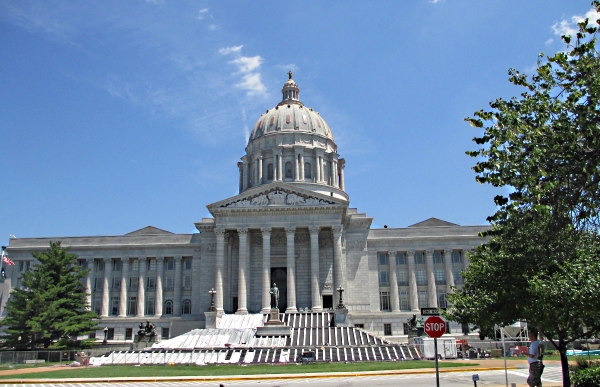
Missouri state capitol at Jeff City. Comes complete with a statue of Mr. Jefferson out front, and a construction project fixing the front steps.
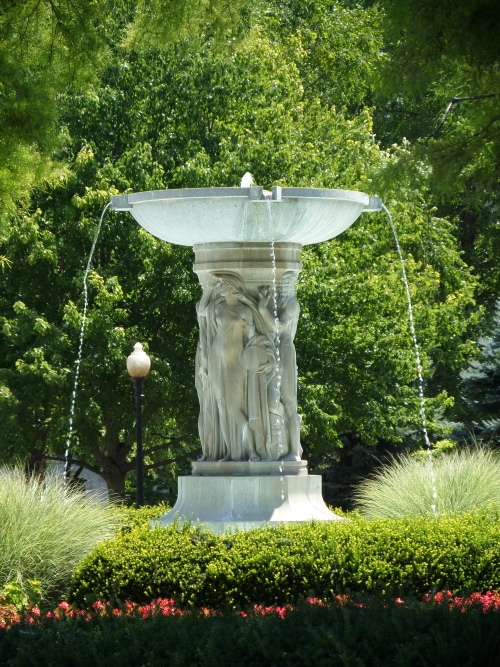
One of a pair of very pretty fountains on the capitol grounds; I believe they’re a war memorial.
However, L mis-reading the map led us off the trail onto a chase after Laura Ingalls Wilder’s final home in Mansfield. (She thought it was on the interstate; it turned out to be fifteen or twenty miles off.) Discovering this killed an hour or two that we hadn’t budgeted for—and we still didn’t get to see the house; the grounds didn’t open until noon and we got there at nine-something in the morning. By the time we got back to the interstate and then to Saint Louis, it was only an hour until the museum closed (they keep short hours on Sunday) and I decided to forget about it, since I wouldn’t have got my money’s worth of looking in just one hour. That can go onto the list for another trip.
Instead, we drove downtown to the Arch, which A wanted reference photos of for some Percy Jackson fanart he’s planning. Downtown turned out to be crammed full of people going to a Cardinals game at Busch Stadium a few blocks away as well as the normal Arch tourists. A took some pictures, I took a few myself for safety, and we passed on the visitors centre (so help me, the Park Service wanted to charge three dollars a head just to visit the gift shop!)
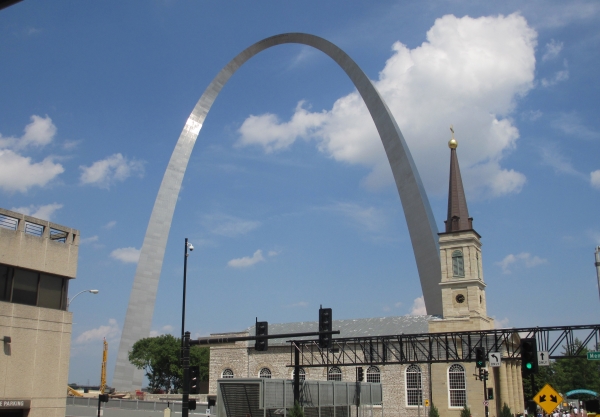
The Arch and the Cathedral Church of Saint Luke
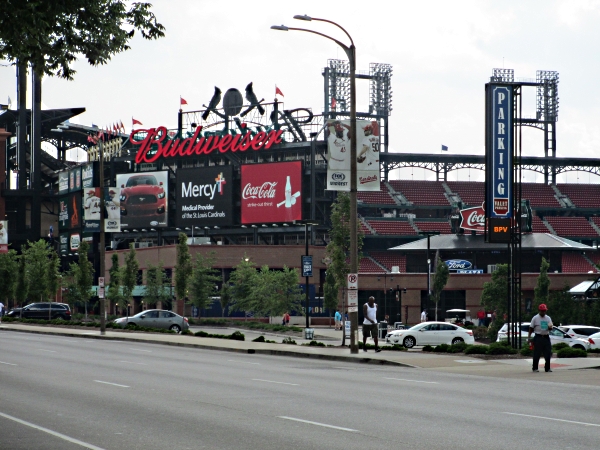
Busch Stadium, taken via telephoto from the safe distance of a block or so
We walked back past the old Catholic cathedral, where I obligingly translated the French inscriptions for A since I can remember enough Latin to stumble along with cognates, up to the Jefferson Westward Expansion Memorial, in the old US court house, which didn’t charge for its gift shop. A was hoping to find some souvenir stickers to put on his new sketchbook’s cover, but they didn’t have anything worth mentioning. Instead we bought a couple of pamphlets about growing and canning fresh berries and some chocolate-mint fudge, which L and A shared. (I think mint is an awful thing to do to a poor, unsuspecting cacao bean.)
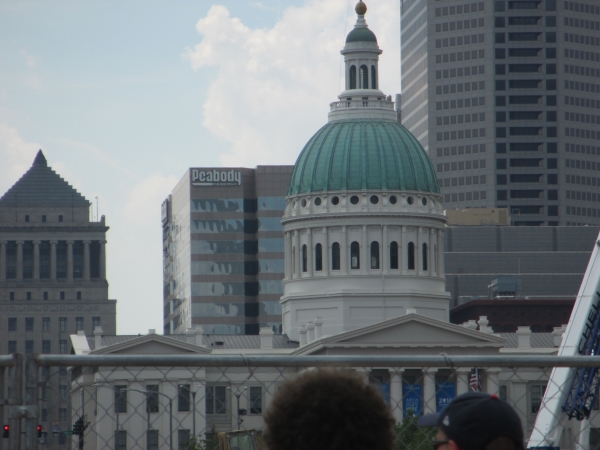
The Old US Court house, now the Jefferson Westward Expansion Memorial, run by the Park Service

The memorial’s cast-iron fence had ornamental land turtles. (The Turtle Moves!)
From Saint Louis we ran on across the line into Illinois and stopped for the night at Springfield to catch another capitol building for A on Monday. (Other kids catch Pokémon. Alyks catches capitols.) The Springfield capitol, while smaller than Austin’s, was quite pretty in a Corinthian-Revival way.
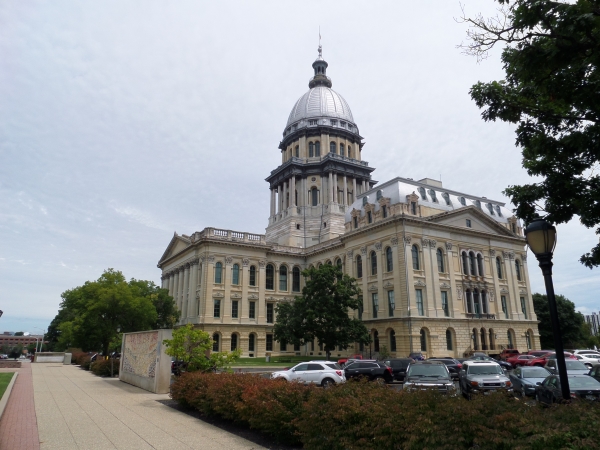
Illinois’s capitol, a bit crowded by state-complex office buildings
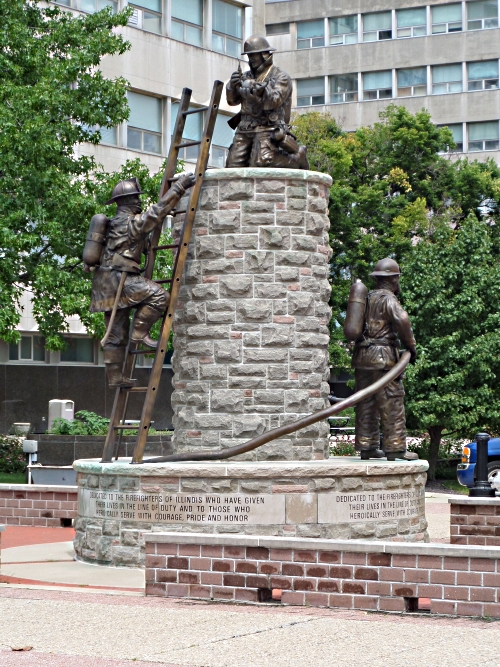
A complex and well-executed stone-and-bronze memorial to fallen Illinois firemen
Right next to it was the Illinois State Museum, which L had planned on and I’m glad she did. It was small but extremely well presented, understandable but not written down to the school field-trip level of literacy. The first floor was all natural history, beginning with the Cambrian and Devonian, and including a life-sized Dunkleosteus bursting through the wall, which L called a “basilisk,” after Harry Potter, and which unnerved A. One display case contained half a dozen complete mastodont mandibles, and another had scale models of an elephant and a mastodont together so you could compare sizes: the mastodont is shorter nose-to-tail, but significantly taller at the shoulder.
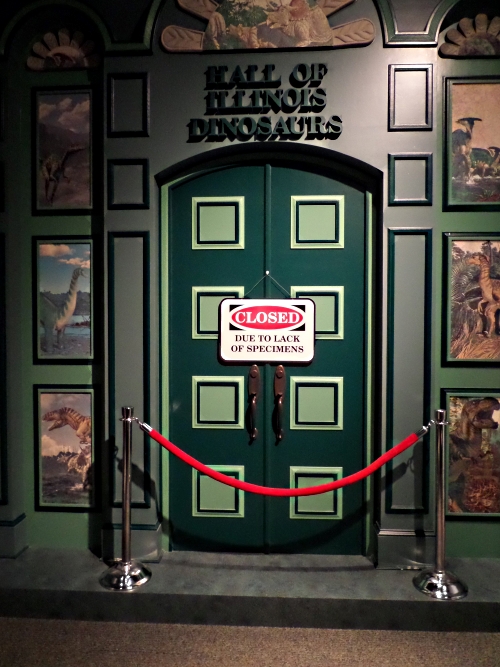
The Illinois Hall of Dinosaurs, permanently closed because nobody has ever found any dinosaurs in Illinois
Upstairs was devoted to human cultures of the state, beginning with daily-use tools and crafts, well presented and clearly laid out. I did scratch my head over staff’s decision to include clay figurines from the Four Corners area; that connection seems kinda tenuous. Much better was an exhibit of quill work, with some beautiful weaving and dyeing and an explanation of how weavers used different thicknesses of quills. Beyond that we found a hall with dioramas of the region’s Native nations ranging from the early Woodland period (ca. 1200 A.D.) to the early 1800s. Thankfully the museum administration seem unafraid of showing buck-naked children and women with bare tits, as Natives would have been prior to Columbian contact. I thought the curators’ attention to detail was impressive; one scene of a couple working in a cornfield even showed trickles of sweat running down their chests.
The next gallery was devoted to American cultures beginning with the territorial period. In the earlier eras, the labels presented viewers with a set of purchase choices among three things a person (farmer, housewife, child) would have wanted or needed, and asked us to decide which the person might have bought, then see whether we second-guessed right. The farmer, for example, had a choice between paying down the mortgage on his land, buying better farm equipment to improve his efficiency, or buying more land to increase the acreage he could plant. (He bought the better farm equipment, both because he could improve his own output and because he could hire out the machines to neighboring farms for cash income.)
In the 20th-century exhibits, we got to look at all the modern labor-saving and technological improvements. Wonders of a 1930s kitchen included an original Waring Blendor, slant-front toaster, original Silex, and dual waffle iron with its woven-cloth power cord, and a scale-model kitchen planner so a housewife, guided appropriately by a decorator or appliance salesman, could try different arrangements of cabinets and appliances to see what would work the best. (My grandmother had one of these; she and I spent several evenings in 1969 and 1970 trying this and that configuration out before my grandfather charged ahead and remodeled the whole house, including the kitchen, to suit his own ideas.)
Beyond the labor-saving 1930s kitchen, we saw a early-1960s living room with commemorative plates of Ike and Mamie on the wall, a rack full of folded-up TV trays, and an astonishing hobnail milk-glass table lamp with a frilled shade that L said looked like a square-dance petticoat. The March of Progress continued on to a 1970s den complete with an original Lava Lamp and console “hi-fi” stereo cabinet, and ended with a stereotypically catastrophic teenage girl’s room circa 1990, clothes strewn on the floor, band posters covering the walls, and a boom box with a stack of cassettes on the dresser. (T had a room like that once.)
By the time we were done, and I had tasted a crabapple off the many trees that dotted the grounds (they were as alum-y astringent as I’d thought), it was past noon and we hurried on to Indianapolis, where we hoped to arrive early enough to look in on their state history museum—but it didn’t happen because time change. The clock said 5:20 as we got to downtown, which meant we’d missed them by a lot, so A and I took pictures of (you guessed it) the capitol building and then threw in the towel.
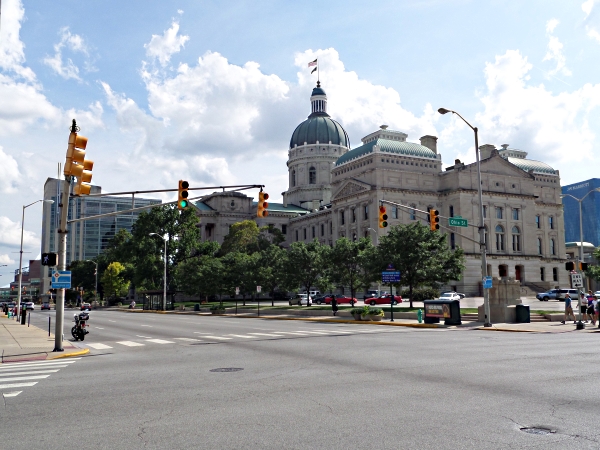
The Indiana Capitol building, an island in a sea of asphalt
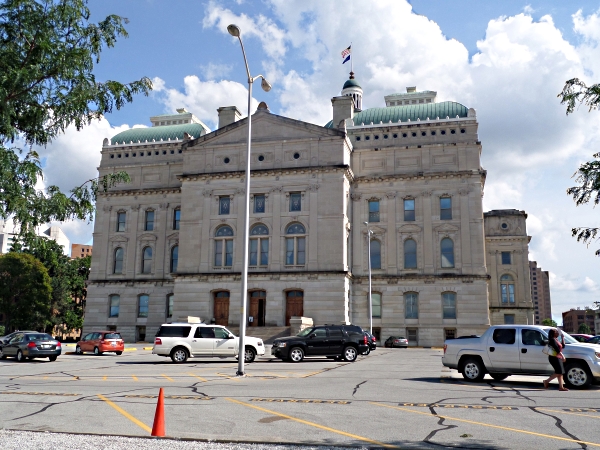
The (non-)majesty of capitol workers’ parking in Indianapolis
I don’t know whose decision it was to pave over nearly all the Indiana capitol’s grounds for parking, but he could just as easy gone and ruined some other piece of the planet for all of me. There’s nothing left but a postage stamp of a lawn directly in front, which only calls attention to its own pathetic state. If I ran the zoo, I’d eminent-domain a couple of adjacent blocks, dynamite the whole mess, and make a respectable park to go around the building that anyone could enjoy.
We couldn’t think of any other reason to hang around Indianapolis, as we were unlikely to run into John Green, so L pointed us toward Springfield, Ohio (our third Springfield in two days) so we could hop into Columbus Tuesday morning and … what were we going to do, boys and girls? Anyone? Yes, that’s right, Susie. We took pictures of the state capitol, which Ohio calls the State House for some reason. Parking in downtown Columbus on Tuesday morning was impossible, so we let A out on the curb to take pictures while I made a block—or tried to, anyhow. I got tangled up in a bunch of one-way streets and had to drive a dozen blocks before I got turned back around right.
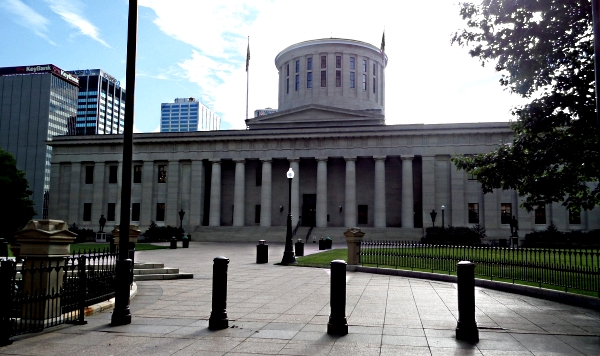
The State House looks strange, like they started out to have a dome but lost interest halfway through.
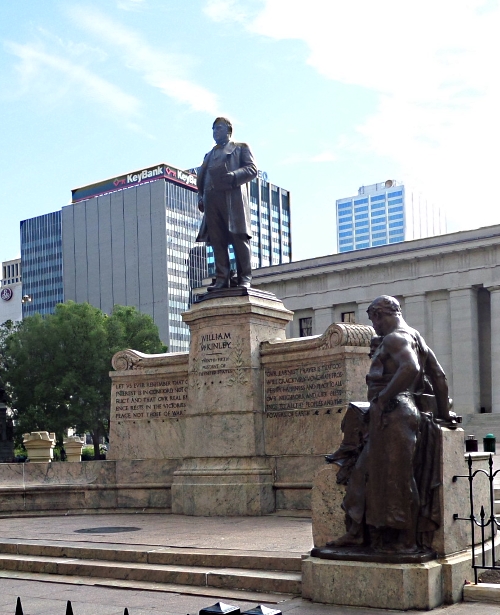
And we have to have a statue of Ohio’s famous son, President (and shooting-gallery target) William McKinley.
Getting lost did have one good effect: I found myself driving past an enormous old-style neon sign for the Columbus Dispatch that I would never have found if I’d been looking for it.
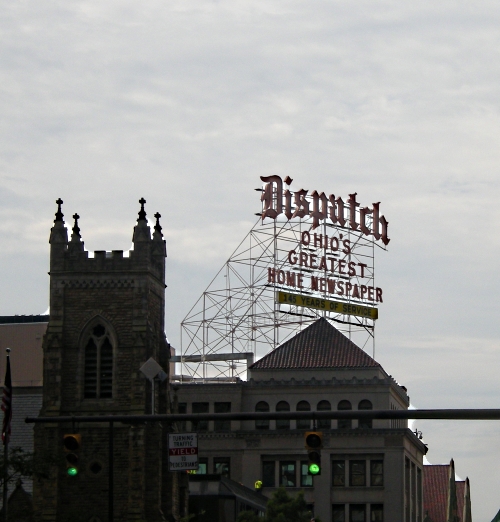
Huge neon sign (which wasn’t lit because daylight) for the Columbus Dispatch
Eventually I got going the right way again, collected A who thought we’d abandoned him, and got out of town after turning the wrong way down only one one-way street.
The rest of the day involved driving and driving and more driving, across the rest of Ohio, all of Pennsylvania, and a bunch of New York before we hauled in at the house of L’s friend Mitchell, our base for doing tourist-in-New-England things.
And in honor of Ohioan John Scalzi, I leave you with an Ohio sunset picture by Alyks.
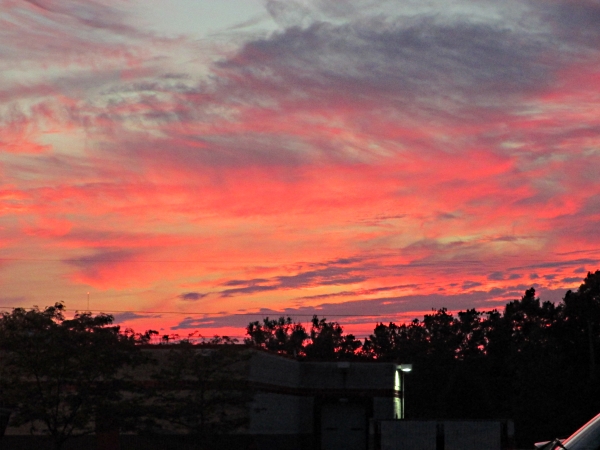

2 Responses to The Capital/Capitol Trip – Days 2 through 4